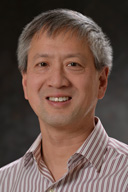
There is continuing interest in increasing the power and improving the beam quality of laser sources for a variety of applications including materials processing, pumping, power transmission, and illumination. One approach is to continue to develop improved lasers with higher power and good beam quality. Another approach, particularly relevant to semiconductor and fiber lasers, is to beam combine large arrays of lasers. Beam combining has become increasing viable over the past decade as the community has developed a better understanding of the requirements imposed by beam combining, and various implementations have been successfully demonstrated in the laboratory. There are two approaches, wavelength beam combining (WBC) and coherent beam combining (CBC), to scaling the brightness by large amounts, in principle by as much as the number of elements. In WBC, the array elements operate at different wavelengths and a dispersive optical system is used to overlap the different wavelengths spatially. This is equivalent to what is done in wavelength division multiplexing for optical communications. In CBC, the beams are interferometrically combined, or phased. If the beams are phased properly, then constructive interference occurs and the power can be combined into a single beam. These implementations are beginning to see commercial application.
* This work was sponsored by DARPA under Air Force contract FA8721-05-C-0002. Opinions, interpretations, conclusions, and recommendations are those of the authors, and are not necessarily endorsed by the United States Government.